Porcelain Insulator News
by Jack H. Tod, NIA #13
Reprinted from "INSULATORS - Crown Jewels of the Wire", April 1984, page 13
Dear Jack:
Last summer I
purchased two boxes of insulators in Virden, Manitoba -- one box of glass ones,
the other of porcelain.
None of the porcelain ones had any markings, but on
closer examination we discovered one insulator with crude printing on it shown
by the exact tracing of it I've enclosed. This was scratched on the insulator
before it was glazed and fired, and the letters are a very dark brown or black
under the medium reddish brown glaze. The thinner glaze spots, especially the
annular rings of the sudden contour changes at the groove area are a creamy sand
color, very pretty.

On checking a map of Pennsylvania, we find there is a place
called Latrobe, so maybe you or one of the readers of Crown Jewels can give us
some information. Any ideas?
I enjoy the informative articles and columns by
you, Marilyn and the other writers. Keep up the good work.
Ken Morrow, NIA #2929
Regina, Sask., Canada
- - - - - - - - - -
Dear Ken:
This U-113 insulator was made by Pittsburg High
Voltage Insulator Co., Derry, Pa., and they exported a great number of these to
Canadian companies. Latrobe is located only about 6 miles from the insulator
plant in Derry.
It's pretty obvious a workman spent some of his break time
scratching his identity onto one or more of the unfired/unglazed insulators, but
I wonder if some of his doings show his name spelled "Clarence". This
is an age-old pastime. For those not fortunate enough to be able to practice it
in automobile or porcelain insulator factories, the proverbial method is to put
your name and address inside a bottle and toss it into the nearby river or
ocean.
I once found an old cone-top soda can in a boulder slide below a rest
stop on a mountainous highway. Inside it was a paper scrap with a name, an
eastern address, a date in the early 1950's and the words "please write to
me". I always intended to write but just never did, and the paper got lost
in the shuffle. This has bothered me ever since, so I feel that I could
partially redeem myself by writing to Latrobe. But maybe it would be more
appropriate if you did that, since you have the specimen right in your hand.
Even though Latrobe is probably many times its 1915 size now, street numbers and
all. maybe an address such as "Clarence Starry or survivors" would
work. The U.S. Postal Service sometimes works wonders and is also sympathetic to
this sort of thing, so maybe you could enclose your unsealed/stamped letter in a
covering request letter to the Latrobe postmaster and ask for his assistance. I
am enclosing a U.S. letter stamp for you in event you care to give it a try. One
catch. If you get a reply from one of Starr's grandchildren confirming the Derry
employment, you just have to let us know about it!
Jack

Dear Jack:
About a year
ago I saw some new U-635 sky-tone units. Below the recess-embossed O-B logo
marking was the new incuse date stamp of "4-79" (April 1979).

Also,
O-B did use sand blast markings on some of their larger unipart pin types. I had
a U-907, chocolate glaze, with the regular recess-embossed "Silent -
Type" marking (above left here) on its large bottom skirt and a sand blast
marking "5-OB-5" on its top skirt.
Robert Winkler
Michigan City,
Indiana
- - - - - - - - - -
Dear Robert:
Thanks for your report. When the factory wrote that the
dating was beneath the B but inside the 0, that didn't sound possible -- and
obviously wasn't.
I was aware of the sandblast markings on multiparts and
non-pintypes, but I think it's unusual for it to appear on even a one-piecer
resembling multiparts. Presumably the numbers in your marking indicate 1955
manufacture.
Jack
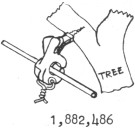
Dear Jack:
The enclosed photo is of an insulator I picked up
from a retired lineman. It weighs about 3 pounds and is about 16-1/2 " from
the tip of the lag screw to the end of the porcelain. The iron yoke is embossed
"PATENTED". Can you tell me what it is?
Ken La Frenier
Townsend, Mass.
- - - - - - - - - -
Dear Ken:
The color photo is nice, but it probably would not come out in the
printing. I've substituted above the sketch of it from the patent section in my
book.
Your insulator is a tree insulator, and the patent on it is shown on page
152 of my "Electrical Porcelain" book -- patent 1,882,486, 8-11-32, W.
H. Cole, Abington, Mass.
The holes in the ends of the mating "sister
hooks" are to accommodate a securing tie wire after the hooks are enclosed
around the conductor wire.
The old and unusual tree insulators are interesting
and desirable items to many collectors, and I'd guess this item would be valued
around $20.
Jack
Elton Gish (Port Neches, Texas) specializes in early U.S.
porcelain insulators and has one of the best collections around of the Imperial,
Fred Locke and other early items. He has consistently been one of our best
reporters on these items and was the source for much of the information on the
early insulator specimens for the published reference books.
He recently sent
another batch of photos of rarities in his collection, and I just have to share
the following two photos with you. You'll probably never see these insulators in
the flesh anywhere unless you visit Elton.
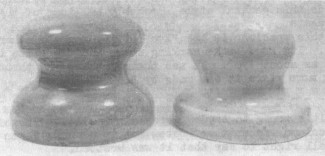
Pictured side by side above are both
sizes of the "Ethridge" insulators, each being one of the rarest of
pin types. These were patent #676,881, June 25, 1901, Harry Ethridge,
McKeesport, Pa. They have a smooth pin hole with a single annular groove at its
top and are rotatable on a special pin with a locking hook on its top.
The
larger brown one is the "No. 2" and is U-376A. It is unattributed to
manufacturer but was probably made by Lima Insulator Co. or Locke, ca.
1901-1910.
The smaller bluish one is "No. 1" and is U-376. This
particular specimen is traceable to a former Lima employee and bears the
"LIMA, N.Y." marking.
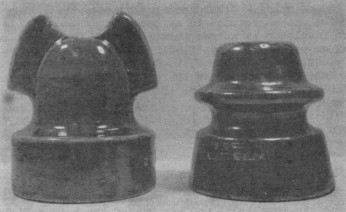
I like to think of the above two insulators as
the real "Adam and Eve" analogy for porcelain pin types, and each of
these specimens is a Fred M. Locke rarity.
The "Roman Helmet"
porcelain design was created by Fred Locke, and this basic design was made by
Locke (and later copied by Thomas) for about 40 years with little change.
At the
right is a U-242 "hat" design used mainly for secondary power
distribution lines from the 1890's to the present day. Virtually every
manufacturer of porcelain pin types made this general style, probably billions
of them in the aggregate.
But this specimen is the "Eve" of it, and
all others followed. Its Fred Locke marking stamp and the glaze type dates it as
about 1902. It was their catalog #44 throughout the 50 or more years it was made
by Locke.
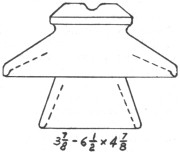
Dear Jack:
Enclosed is a dimensioned sketch of an early glazeweld that
I picked up not too long ago. It is something like the U-962 yet quite different
in several ways and dimensionally. Should it be added to the U- Chart?
Most
U-962's I have seen have a red-orange glaze like that used by Locke in the
1906-1925 era, but this one has a tan and yellow-brown glaze like Fred Locke
used. Unfortunately, it's unmarked.
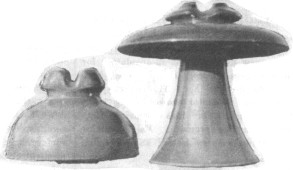
Also enclosed is a photo of my 2 favorite
insulators. The one on the left is a U-746 New Lexington with their marking. The
large lilly-shell is a 30 Kv New Lexington, also with their marking.
Mike Spadafora, NIA #1869
Goldsboro, N.C.
- - - - - - - - -
Dear Mike:
The 6-1/2" glazeweld will
be U-961 in the Universal Style Chart, and I've shown above a preliminary scale
sketch of it. This specific style was shown as the #406-1/2A in the 1905 Ohio
Brass Co. catalog of "Victor" insulators when they were selling agents
for the Locke line. I presume Locke might have furnished unmarked insulators for
resale by other companies such as Ohio Brass Co.
Hopefully the photo of the two
New Lexingtons will come out in the printing at least enough to indicate their
general size and shape. It's rare for anyone to have any marked New Lexington
insulator; it's rarer to have such a pretty one; and it's practically unheard of
for anyone to have two different ones in the same household.
Jack
Over the
years, Elton Gish (Texas) has kept our files staffed with information he has
gleaned from researching old trade journals and technical magazines, and this
has been helpful in answering many questions about what went on in the very
early years of the electrical power industry.
The following clipping is from
Electrical Review, the issue of April 4, 1908. It is very typical of the
editorial style of that era and the extent to which manufacturers such as Fred
Locke tried to promote their new products.
The Lima Insulator Co. plant was
almost totally destroyed in a fire September 1908. Judging from this ridiculous
insulator design concept, maybe just as well?
|
Insulators for Extremely
High-Voltage lines.
The accompanying illustrations show some new developments in
insulators for high-voltage lines which have been brought out by Fred M. Locke.
The frame-type insulator shown in Fig 1 has been designed for lines requiring
150, 000 volts line pressure.
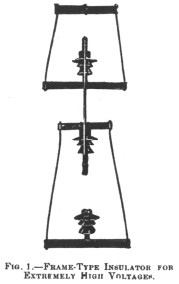
This insulator will stand a spray test of 280,000
volts. leaving a large factor of safety. It will carry a mechanical load of
20,000 pounds, and can be constructed to carry as much more as desired by
increasing the I-beams and side rods and the bearing surface of the porcelain.
The frames are interlocked like a chain, and the line can not come down. All the
porcelain parts are under compression and are designed to have a surface large
enough to carry the required mechanical load with a large factor of safety.
Under an electrical test this insulator does not show the usual static stresses,
and is extremely quiet up to the arcing point which takes place between the
frames. In case of an arc from lightning, this will take place between the
frames and not injure the insulator. These insulators are furnished in any size
for line voltages from 70,000 volts up to 300,000 volts, with a factor of safety
of two under a spray test and any mechanical load desired. The insulator is
designed for the hanging type, but can be supported at either end, and may be
used horizontally or perpendicularly. The insulator is manufactured exclusively
by the Lima Insulator Company, Lima, N. Y., under Mr. Locke's rights to patent
which are now pending.
|
The book Porcelain Insulators Guide Book for Collectors,
Second Edition, 1976, has been out of print since 1980 in its original form of
printing/binding. Since then, I have annually made up a small new batch by hand
binding. This also affords the advantage of being able to update the books.
I
thought it would be nice to get this updating info to those who obtained the
book several years ago, a possible solution being to put all this info on a
couple of sheets and asking people to send a SASE for a gratis Xerox copy. A
real mess -- the postage expense and a real paper-mill.
Alas! Mike Spadafora
(N.C.) to the rescue by suggesting the following in a recent letter.
"There
have been something like 15 or 16 new U- Chart additions since the book was
published in 1976. It would be a big help if you could run all of these in CJ as
a pullout sheet like you did in 1977 for the index of porcelain column articles.
We could then remove this sheet and add it to our insulator books."
So here
it is. Just remove this centerfold sheet and put it in your insulator book. It
contains all the real meat of the additions to the book since 1976.
Jack

GOULD,
INC.
ITE Imperial merged with Gould, Inc. on May 1, 1976, and the name change to
Gould, Inc, became official on December 1, 1976. The ITE marking formerly used
on insulators made at the Victor, N.Y. insulator plant was phased out in 1977,
and the pin types were then marked with an incuse stamp representing the Gould,
Inc. logo as shown above.

BROWN, BOVERI & COMPANY
In 1980, Gould entered
into a joint venture with Brown, Boveri and Co. of Baden, Switzerland, and the
Victor, NY plant operated as Gould-Brown Boveri, with continued use of the Gould
logo marking. In late 1981, Gould sold its interest in the joint venture to BBC,
and the former I-T-E divisions became Brown Boveri Electric, Inc., a subsidiary
of BBC. The BBC marking on insulators commenced at that time.

PITTSBURG H.V.I. CO.
The marking shown at the right has been reported on a U-709A manufactured by
Pittsburg High Voltage Insulator Co.

OHIO BRASS COMPANY
In recent years the O-B
monogram markings carry a manufacturing date. The first number(s) is the month,
and the last two numbers are the last two digits of the year.
The company
advised that this dating was beneath the B and within the 0, but collectors have
reported specimens with the dating (incuse numbers) underneath the regular
recess-embossed O-B logo stamping.

The 'GLEN' marking (rare) is known on
white-glaze U-38, most probably made by Fred M. Locke, ca. 1898-1901.
The MACY
marking is known circularly embossed on the crown of U-124 dry press specimens,
and it is unattributed. The insulators were probably made by Square-D Co., Peru,
Indiana, ca. 1930's.

In September 1975 Porcelain Products Co. bought Knox
Porcelain Corp. and incorporated the Knox items into the products sold by PP
representatives. They started marking all products with both the PP and KNOX
logos (underglaze), reportedly using a single integral handstamp device.
Pricing
Guide Values shown are only the author's best guess as to probable Value. Some
of these items are very rare to unique, and values may not have been established
by actual sale of specimens at this time.
|
U-
|
|
$$
|
|
40
|
Fred M. Locke, tan-brown
|
45
|
124
|
"MACY INSULATOR", brown
|
125
|
|
190
|
Cap part
|
20
|
|
219
|
N.N., brown
(cemented)
|
200
|
|
219A
|
N.N., brown
(cemented)
|
200
|
|
376
|
N.N., brown or light blue
|
*
|
|
392
|
N.N., brown
|
80
|
|
408A
|
Locke, brown
|
125
|
|
930
|
Imperial, white
|
40
|
|
935B
|
N.N., white
|
60
|
|
940B
|
Imperial/Locke, white
|
65
|
|
941
|
Fred M. Locke, white
|
110
|
|
954B
|
N.N., brown
|
20
|
|
975
|
N.N., brown shades
|
275
|
|
983
|
N.N., mottled brown
|
700
|
(*) Probably unique; no
guess as to value.
Porcelain Insulators Guide
Book, Second Edition, 1976
UNIVERSAL STYLE CHART, Added items
since 1976.
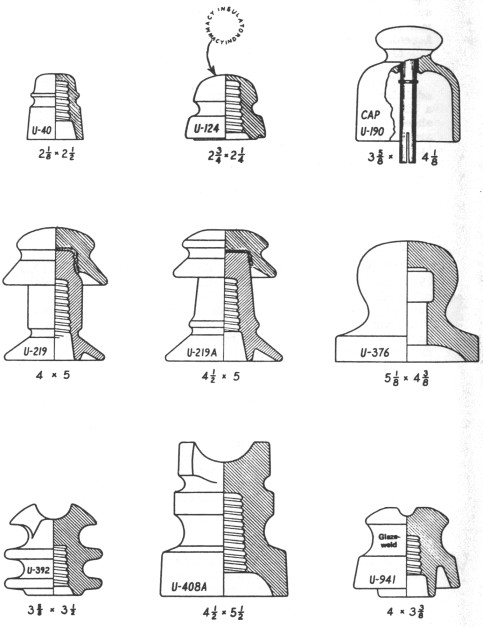
Large Image (103 Kb)
- - - - - - - - - - -
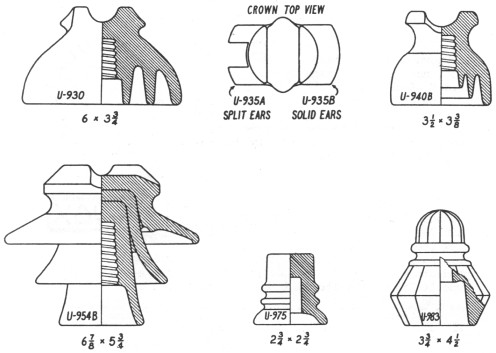
Large Image (66 Kb)
INSULATORS -- CROWN JEWELS OF THE WIRE, April
1984
| 